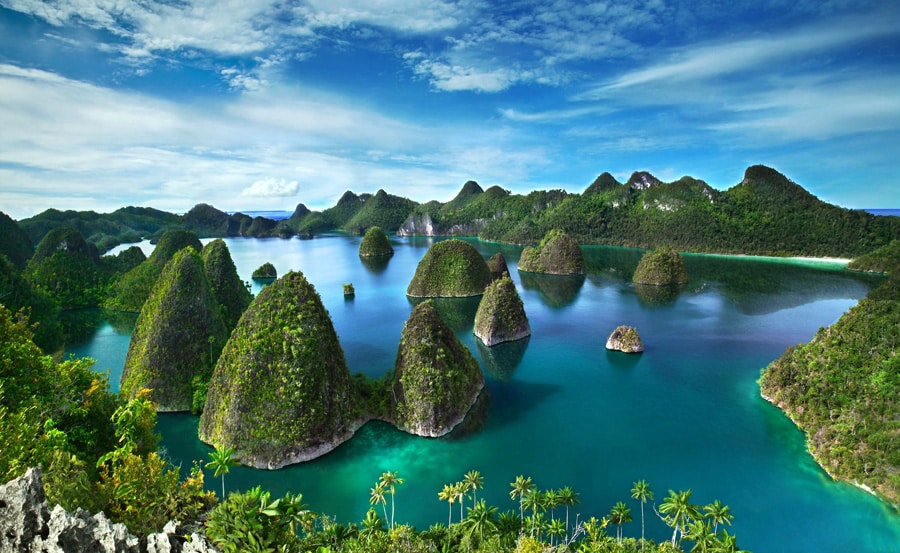You’ll find Raja Ampat on the island of New Guinea in Indonesia’s West Papua province. Raja Ampat translates to “Four Kings”. The island takes its name from the four main islands of the archipelago.
The island contains some of the most biodiverse waters in the world.
The park extends over 9.8 million acres of land and sea, home to 540 types of corals, more than 1,000 types of coral fish and 700 types of mollucks. Making Raja Ampat the number 1 for liveaboard diving in Indonesia.
The bad news is that not many divers know about this hidden gem. The good news is that not many divers know about this hidden gem.
If you are not into diving sites that draw crowds comparable to Times Square on New Year’s Eve, then get yourself on an Indonesian liveaboard that dives Raja Ampat.
If you don’t know much about Raja Ampat, or (like most folks) don’t know anything at all about it, and you are wondering what the best spots to dive, fear not, we are here to help.
The area is often considered the last true diving paradise on earth. There are many amazing dive spots here, but we’ll list a few of the jewels:
Changgo
The depths here range from 16 feet (5 meters) to 105 feet (32 meters), with the best diving around the 65-foot (20-meter) mark. The thing that stands out about Chango is the landscape. It is a wide-angle photographer’s dream. The shore is lined with rock formations with tree roots from the above trees.
Further down are an amazing series of cracks and ridges. Still further down is a sheer wall, which includes a stunning archway.
Accessing the site involves some timing, due to intermittent strong currents. If your liveaboard captain happens to give it a thumbs up, you’ll be happy Mother Nature opened the door (temporarily) to this beauty.
Boo island
Nothing to be afraid of here. Well unless you are deathly afraid of green turtles because there is an abundance here.
When you first arrive, you’ll notice two rocks a short distance apart breaking the surface. There is prime diving between these two structures. There is an impressive swim through that is best explored on the way back to the boat.
Another “scary” (intended sarcasm) aspect of the site is all the unicornfish, surgeonfish, and blue dash fusiliers that mob divers. If you like wall diving and you like an overabundance of marine life, you’ll like Boo Island.
Kaleidoscope
If you ever looked through a kaleidoscope as a child, you have a pretty good idea of the array of colors you’ll witness at this Misool Island site. Vivacious shades exude from an expansive wall of coral inhabited by nudibranchs and the occasional pygmy seahorse.
Depths range from 15 feet (5 meters) to around 100 feet (30 meters). Currents are calm and the water temperature reaches 86˚F (30C). It’s like diving a bathtub. Well if your bathtub was the size of several football fields and had a ton of sea life in it.
Many liveaboards diving Raja Ampat pick Kaleidoscope as a night dive location. If you happen to dive the site at night, you won’t have to wonder why they do.
Cross wreck
If wreck diving is your thing, request for your liveaboard to visit the cross wreck. It’s called cross wreck because it’s at the landing site of the first Christian missionaries to the area.
The wreck was a Japanese naval patrol boat and lies in 60 feet (18 meters) of water. Much of the vessel is still intact (although it has been taken over by sponges and soft coral), and it is penetrable.
Sailors no longer man the boat; instead, it is staffed by scorpionfish, hump head parrotfish, napoleon wrasse, moray eels, and lionfish.
Liveaboard diving in Raja Ampat
If there is a diver who has dove Raja Ampat and was disappointed, we haven’t met them. This hidden treasure is often picked by the (few) people who have experienced it, as their all-time favorite.
The best time to dive Raja Ampat is from October to April, but that is due to the weather. The actual diving is great year-round.
It is recommended divers be at least intermediate level diver, because of the occasional unexpected current surges.
For more info about this “best-kept secret of diving”, get in touch with us at Calico Jack Charters.



